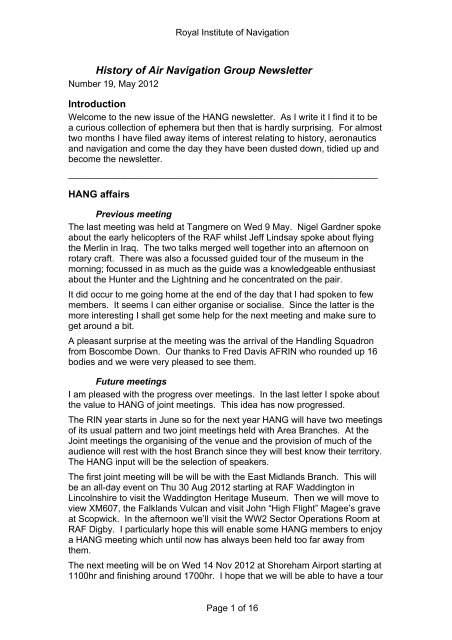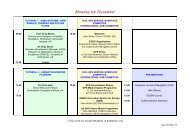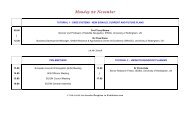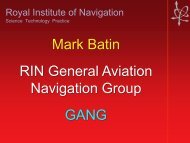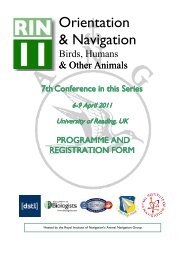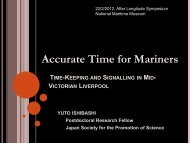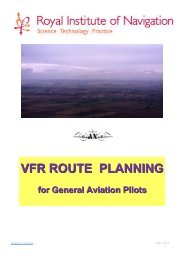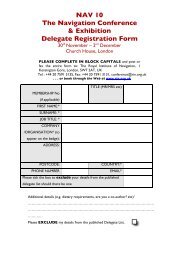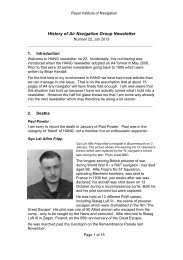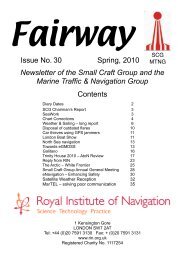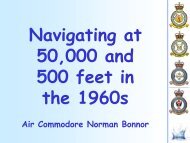HANG Newsletter - Royal Institute of Navigation
HANG Newsletter - Royal Institute of Navigation
HANG Newsletter - Royal Institute of Navigation
You also want an ePaper? Increase the reach of your titles
YUMPU automatically turns print PDFs into web optimized ePapers that Google loves.
<strong>Royal</strong> <strong>Institute</strong> <strong>of</strong> <strong>Navigation</strong><br />
History <strong>of</strong> Air <strong>Navigation</strong> Group <strong>Newsletter</strong><br />
Number 19, May 2012<br />
Introduction<br />
Welcome to the new issue <strong>of</strong> the <strong>HANG</strong> newsletter. As I write it I find it to be<br />
a curious collection <strong>of</strong> ephemera but then that is hardly surprising. For almost<br />
two months I have filed away items <strong>of</strong> interest relating to history, aeronautics<br />
and navigation and come the day they have been dusted down, tidied up and<br />
become the newsletter.<br />
_____________________________________________________________<br />
<strong>HANG</strong> affairs<br />
Previous meeting<br />
The last meeting was held at Tangmere on Wed 9 May. Nigel Gardner spoke<br />
about the early helicopters <strong>of</strong> the RAF whilst Jeff Lindsay spoke about flying<br />
the Merlin in Iraq. The two talks merged well together into an afternoon on<br />
rotary craft. There was also a focussed guided tour <strong>of</strong> the museum in the<br />
morning; focussed in as much as the guide was a knowledgeable enthusiast<br />
about the Hunter and the Lightning and he concentrated on the pair.<br />
It did occur to me going home at the end <strong>of</strong> the day that I had spoken to few<br />
members. It seems I can either organise or socialise. Since the latter is the<br />
more interesting I shall get some help for the next meeting and make sure to<br />
get around a bit.<br />
A pleasant surprise at the meeting was the arrival <strong>of</strong> the Handling Squadron<br />
from Boscombe Down. Our thanks to Fred Davis AFRIN who rounded up 16<br />
bodies and we were very pleased to see them.<br />
Future meetings<br />
I am pleased with the progress over meetings. In the last letter I spoke about<br />
the value to <strong>HANG</strong> <strong>of</strong> joint meetings. This idea has now progressed.<br />
The RIN year starts in June so for the next year <strong>HANG</strong> will have two meetings<br />
<strong>of</strong> its usual pattern and two joint meetings held with Area Branches. At the<br />
Joint meetings the organising <strong>of</strong> the venue and the provision <strong>of</strong> much <strong>of</strong> the<br />
audience will rest with the host Branch since they will best know their territory.<br />
The <strong>HANG</strong> input will be the selection <strong>of</strong> speakers.<br />
The first joint meeting will be will be with the East Midlands Branch. This will<br />
be an all-day event on Thu 30 Aug 2012 starting at RAF Waddington in<br />
Lincolnshire to visit the Waddington Heritage Museum. Then we will move to<br />
view XM607, the Falklands Vulcan and visit John “High Flight” Magee’s grave<br />
at Scopwick. In the afternoon we’ll visit the WW2 Sector Operations Room at<br />
RAF Digby. I particularly hope this will enable some <strong>HANG</strong> members to enjoy<br />
a <strong>HANG</strong> meeting which until now has always been held too far away from<br />
them.<br />
The next meeting will be on Wed 14 Nov 2012 at Shoreham Airport starting at<br />
1100hr and finishing around 1700hr. I hope that we will be able to have a tour<br />
Page 1 <strong>of</strong> 16
<strong>Royal</strong> <strong>Institute</strong> <strong>of</strong> <strong>Navigation</strong><br />
<strong>of</strong> the airport in the morning; Shoreham <strong>of</strong>fered this last time but withdrew the<br />
invitation at the last moment on grounds <strong>of</strong> safety. The selection <strong>of</strong> speakers<br />
is almost complete.<br />
The second joint meeting will be with the Solent Branch <strong>of</strong> RIN. It will be held<br />
on Thu 14 Mar 2013 at the <strong>Royal</strong> Lymington Yacht Club. We are negotiating<br />
with a speaker and I can give you details in the next newsletter.<br />
The fourth meeting will again be one <strong>of</strong> traditional <strong>HANG</strong> format on Wed 15<br />
May 2013 at the Tangmere Military Aviation Museum. The meeting will run<br />
from 1100hr to 1700hr with a small event in the morning and two speakers in<br />
the afternoon.<br />
This programme will give <strong>HANG</strong> four meetings spread through the year and it<br />
will be interesting to see if members find this format suits them better.<br />
<strong>HANG</strong> and <strong>Navigation</strong> News<br />
Every two months a new copy <strong>of</strong> <strong>Navigation</strong> News is published. A portion <strong>of</strong> it<br />
is allocated to Special Interest Groups so <strong>HANG</strong> has an input. What do we do<br />
with this opportunity? An obvious use is to publicise the next <strong>HANG</strong> meeting.<br />
After that, what else is there to say? I like to add a few words on some<br />
aspect <strong>of</strong> the history <strong>of</strong> air navigation.<br />
I can either use something already published in the <strong>HANG</strong> newsletter or write<br />
something from scratch. I have decided to do the former. I apologise to those<br />
members who are not interested in reading something twice but that way<br />
there is continuity – anything that <strong>HANG</strong> has published will be found in one or<br />
other <strong>of</strong> the newsletters and, with one exception, I have copies available <strong>of</strong> all<br />
back numbers.<br />
Missing <strong>HANG</strong> newsletter<br />
I have one gap in my collection <strong>of</strong> back-numbers <strong>of</strong> <strong>HANG</strong> newsletters; in fact<br />
I am not even certain that I wrote it but there is an entry in my list. Does<br />
anybody have a copy <strong>of</strong> a <strong>HANG</strong> newsletter for December 2009 (or at least<br />
within one month <strong>of</strong> this date)? It might have the issue number 12 but I might<br />
have retrospectively numbered the newsletters at a later date.<br />
_____________________________________________________________<br />
RAF Gee charts<br />
Walter Blanchard recently sent me some information about Gee. I thought I<br />
would first bring myself up to speed on Gee (for Grid) so I quote Wikipedia..<br />
Gee was the code name given to a radio navigation system used by the <strong>Royal</strong><br />
Air Force during World War II. It was the first hyperbolic navigation system to<br />
be used operationally.<br />
Gee was devised by Robert Dippy and developed at the Telecommunications<br />
Research Establishment (TRE) at Swanage. Gee was originally designed to<br />
improve aircraft navigation accuracy, and improve safety during night<br />
operations. In practice, it was also used as a bombing navigation system,<br />
thereby increasing the destructiveness <strong>of</strong> bomber raids. For large fixed<br />
targets, like the cities that were attacked at night, Gee <strong>of</strong>fered enough<br />
Page 2 <strong>of</strong> 16
<strong>Royal</strong> <strong>Institute</strong> <strong>of</strong> <strong>Navigation</strong><br />
accuracy to be used as an aiming reference without the need to use a<br />
bombsight or other external reference.<br />
Gee installation in a Lancaster bomber mock-up. Photo credit jproc.ca.<br />
Dippy later went to the United States where he worked on the development <strong>of</strong><br />
the LORAN system, a system that was similar to Gee but using a longer<br />
wavelength. LORAN was used by the US Navy and <strong>Royal</strong> Navy during World<br />
War II, and after the war came into common civilian use worldwide for coastal<br />
navigation, until GPS made it obsolete.<br />
Gee was also known as AMES Type 7000, for "Air Ministry Experimental<br />
Station". AMES was a common universal naming system in the UK, similar to<br />
the "AN" series in the US.<br />
Walter said…<br />
Images 1 and 2. Photo credit Walter Blanchard.<br />
“I have in my possession a well-used folder <strong>of</strong> miniature GEE charts - see<br />
image 1 - salvaged from a rubbish bin at Shawbury in 1957. It contains a set<br />
<strong>of</strong> 41 small lattice charts covering the UK GEE chains. An example is at<br />
image 2.<br />
Page 3 <strong>of</strong> 16
<strong>Royal</strong> <strong>Institute</strong> <strong>of</strong> <strong>Navigation</strong><br />
Images 3 and 4. Photo credit Walter Blanchard.<br />
There is a legend in the lower left <strong>of</strong> several charts (the actual numbers vary<br />
from chart to chart) which might date it - see image 3. Also, a page is<br />
included giving details <strong>of</strong> the GEE chains which has a list <strong>of</strong> the various lattice<br />
chart reference numbers - image 4.<br />
If I read the legend correctly there were no less than 50,000 printed in<br />
February 1945. They were obviously intended for hard use being printed on<br />
cloth-backed paper. The large single-sheet lattice charts are familiar but<br />
these books appear to have been less common. Because <strong>of</strong> their small size<br />
they might have been easier to use in small cockpits e.g. Mosquito, which<br />
might have been the reason for their issue.<br />
Can anyone confirm this or supply more information on why they were<br />
produced?”<br />
As a foot note it is interesting to realise that Gee was almost compromised<br />
before it began.<br />
On the night <strong>of</strong> 11 Aug 41 two Gee-equipped aircraft bombed using Gee<br />
coordinates only and delivered "uncanny accuracy". However, on the next<br />
night on a raid over Hanover a Gee-equipped Vickers Wellington was lost.<br />
The Gee set did not contain self-destruct systems and it was possible that it<br />
had fallen into German hands. Operational testing was immediately<br />
suspended.<br />
RV Jones, the chief operational scientist in MI6, responded by starting a<br />
disinformation campaign to hide the existence <strong>of</strong> the system. First, the use <strong>of</strong><br />
the codename 'Gee' in communications traffic was dropped, and false<br />
communications were sent referring to a fictitious system called 'Jay'; it was<br />
hoped the similarity would cause confusion. Extra antennae were added to<br />
the Gee transmitters to radiate false, unsynchronized signals. A double agent<br />
in the Double Cross system reported to German Intelligence a fictional story<br />
<strong>of</strong> hearing a couple <strong>of</strong> RAF personnel talking carelessly in a hotel about Jay,<br />
and one dismissing it as it was "just a copy" <strong>of</strong> the German Knickebein<br />
system. Jones felt this would flatter the Germans, who might consider the<br />
information more reliable as a result. Finally, false Knickebein signals were<br />
transmitted over Germany.<br />
Page 4 <strong>of</strong> 16
<strong>Royal</strong> <strong>Institute</strong> <strong>of</strong> <strong>Navigation</strong><br />
Jones initially calculated it would be only three months before the Germans<br />
would be able to jam the system. As it turns out, it was not until five months<br />
into the campaign that jamming was encountered and longer before it became<br />
a serious concern.<br />
_____________________________________________________________<br />
Readers’ letters<br />
<strong>Newsletter</strong> circulation<br />
When I circulated the last newsletter I said that I favoured sending the<br />
newsletter to each member so that he received it on his computer as an<br />
attachment to be down loaded or deleted. I thought that the idea <strong>of</strong> posting it<br />
on the main web site and alerting people to that fact did not actually work well.<br />
I have the greatest difficulty using the web site presumably because I don’t<br />
use it enough. The fact remains that I received various notifications <strong>of</strong> the<br />
central posting <strong>of</strong> newsletters but have rarely had the time, or enthusiasm, to<br />
actually come out <strong>of</strong> my email programme and go the website at that moment.<br />
Dick Clements has recently written to me to express his disapproval. He finds<br />
an attached newsletter to cause his inbox to overflow, to constitute<br />
unnecessary traffic and to not be best practice…<br />
“Whilst I know there are some arguments for distributing the <strong>Newsletter</strong><br />
directly to each member <strong>of</strong> the <strong>HANG</strong> group, there are also counter<br />
arguments. In my case the attachment causes my inbox to overflow and<br />
restrict my receipt <strong>of</strong> other things. There is also the volume <strong>of</strong> (arguably<br />
unnecessary) traffic generated by such mailings. The posting <strong>of</strong> newsletters<br />
and similar items on an accessible central repository, together with a simple<br />
notification email to those likely to wish to collect it from the repository is<br />
accepted best practice in a wide variety or organisations. For my part, I would<br />
vote for the "collect the newsletter from the RIN site" solution.<br />
Hope it's helpful to have views from the members <strong>of</strong> the group.”<br />
This newsletter will probably still be circulated the old way – not because I<br />
have ignored Dick’s wishes but because I am short on time trying to finish by<br />
the end <strong>of</strong> the month. I shall look into publishing the following newsletter as a<br />
link embedded in an email. I want the member to be able to move from<br />
reading his email to reading his newsletter by a single stroke. Until now he<br />
must click the ‘download’ caption. If attachments are replaced by links then<br />
he still only has to make one click – but now onto the link. Either can be done<br />
without exiting from the email programme. The newsletter will no longer be a<br />
threat to the overflowing <strong>of</strong> the inbox. Two more months should give me time<br />
to find out how to do it.<br />
Pinpoint the Bomber<br />
In the last newsletter I referred to two publications in WW2 by Francis<br />
Chichester. This resulted in an email from Reg Brindley…<br />
Out <strong>of</strong> interest I have a book printed in 1942 called Pinpoint the Bomber - The<br />
Great Air Game Book written by Francis Chichester. It's basically an air<br />
Page 5 <strong>of</strong> 16
<strong>Royal</strong> <strong>Institute</strong> <strong>of</strong> <strong>Navigation</strong><br />
navigation game mounted inside a book, and is designed to teach people air<br />
navigation through a fictitious raid into Germany during WW2.<br />
I have the same book and count myself lucky. I saw a copy at a book fair – it<br />
was somewhat battered, priced around £35 and seemed not enough for the<br />
money. By the time second-thoughts kicked in it had gone. It was 2 to 3<br />
years before I found another copy for sale and that time I did buy it. In its own<br />
way it is a navigation simulator. There are aerial photographs <strong>of</strong> features en<br />
route – since these are not the expected landmarks the reader is expected to<br />
work out where they are from the chart and what correction must be made. I<br />
will give the book closer attention soon and give a better description then.<br />
PS: Like London buses…I saw another copy at a book fair only last week.<br />
_____________________________________________________________<br />
Air Pilotage<br />
1935 and 1941 issues <strong>of</strong> AP1234. Photo credit pkh-l.<br />
AP1234 will be familiar to many as the RAF manual on air navigation. Most <strong>of</strong><br />
the copies that are to be found now are <strong>of</strong> the second edition that was written<br />
by Dickie Richardson with help from Francis Chichester in 1941 and re-issued<br />
for the public in 1944.<br />
Although the RAF air navigation manual was always designated AP1234<br />
there were considerable differences as the book evolved. The 1941 second<br />
edition was a hardback book about 7x10 inches entitled “Air <strong>Navigation</strong>”. The<br />
pre-war issue <strong>of</strong> 1935 was a smaller book, about 6x9 inches, entitled “Manual<br />
<strong>of</strong> Air <strong>Navigation</strong>”; it was loose leaf and bound with string between cardboard<br />
covers. However AP1234 came into existence in 1927, again string bound<br />
between hard covers, and titled “Manual <strong>of</strong> Air Pilotage”.<br />
I was interested in the nomenclature. Why did “Air Pilotage” become “Air<br />
<strong>Navigation</strong>”? The answer was to be found in the Flight issue <strong>of</strong> 14 Feb 35<br />
p.173 in the section “<strong>Royal</strong> Air Force - Service Notes and News and Air<br />
Ministry announcements”. One announcement was as follows…<br />
“It has been decided that the use <strong>of</strong> the term “air pilotage” is to be<br />
discontinued. In all correspondence and reports relating to the subject the<br />
term “air navigation” is to be used. The following changes <strong>of</strong> title will be<br />
made. (i) Air Pilotage School to be Air <strong>Navigation</strong> School. (ii) The 13 weeks <strong>of</strong><br />
Page 6 <strong>of</strong> 16
<strong>Royal</strong> <strong>Institute</strong> <strong>of</strong> <strong>Navigation</strong><br />
Air Pilotage Course to be Short <strong>Navigation</strong> Course. (iii) The N course at RAF<br />
Calshot to be Specialist <strong>Navigation</strong> Course. (iv) Manual <strong>of</strong> Air Pilotage<br />
(AP1234) to be Manual <strong>of</strong> Air <strong>Navigation</strong> Vol I. (v) Manual <strong>of</strong> Air <strong>Navigation</strong><br />
(AP1456) to be Manual <strong>of</strong> Air <strong>Navigation</strong> Vol II. Air pilotage <strong>of</strong>ficers will be<br />
known as ‘navigation <strong>of</strong>ficers’ and will be denoted by the symbol (sn) in the<br />
List <strong>of</strong> Units in the Air Force List when filling vacancies which <strong>of</strong>ficers so<br />
qualified are allowed. Specialist N <strong>of</strong>ficers will continue to be identified by the<br />
symbol N in the graduate list and by the symbol (n) when filling vacancies for<br />
which <strong>of</strong>ficers so qualified are allowed.<br />
AP1234 (1927) Manual <strong>of</strong> Air Pilotage. Photo credit pkhl.<br />
I noticed elsewhere that AP1234 1927 “Manual <strong>of</strong> Air Pilotage” had been<br />
described as a re-issue <strong>of</strong> AP44 (1920). So, where can I find AP44 1920<br />
“Notes on Air Pilotage” ?<br />
_____________________________________________________________<br />
Enquiries<br />
Hannibal’s <strong>Navigation</strong><br />
Since the <strong>Institute</strong> is the principle authority on navigation in the UK it is not<br />
just unsurprising but it is a pleasure to read <strong>of</strong> the exchange recently between<br />
RIN and Dr Lothar Stenger. He wrote …<br />
First <strong>of</strong> all I hope, that you can excuse my faulty knowledge <strong>of</strong> the English<br />
language - thank you.<br />
The following questions were sent to the German <strong>Institute</strong> <strong>of</strong> <strong>Navigation</strong><br />
(DGON) in Bonn/Germany some days ago, but the answer was not very<br />
complete. Mr Gronemann/DGON gave me your address and the idea, to ask<br />
you the same questions:<br />
I am interested to know, for example, how Hannibal found his way through the<br />
alps to attack the Roman, without any maps or somewhat else, we use today.<br />
The similar question is for me, how Alexander the Great succeeded coming to<br />
India and back again. I think, here were not only problems with the geographic<br />
situation, but further the differfent languages.<br />
Page 7 <strong>of</strong> 16
<strong>Royal</strong> <strong>Institute</strong> <strong>of</strong> <strong>Navigation</strong><br />
Hannibal crossing the Alps. Photo credit SAAP.<br />
I do not hesitat to say you, whose brain has such questions: I am chemist, but<br />
still pensioner; my favorite interest is the evolution <strong>of</strong> mankind in all its<br />
amazing spheres. I ask you for your help concerning my lacks in knowledge.<br />
In the discussions that followed nobody seemed to produce a more<br />
convincing answer than Terry Hayward who said… “I’m a simple soul but I<br />
have always thought that they ‘persuaded’ a local to show them the way”<br />
Our Director sent this suggestion to Dr Stenger so we leave the last word with<br />
Dr Stenger…<br />
Thank you very much for your answer and the work you have had to find it.<br />
Your answer is helpful for me to understand a litle bit more about the<br />
development <strong>of</strong> the civilisation. It seems, that trading has been a very<br />
important thing in "making" the streets through the continents and that this<br />
way <strong>of</strong> communication has grown in the development <strong>of</strong> our species in<br />
hundreds and thousands <strong>of</strong> years.<br />
Nevertheless, it is amazing for me, how they found their aim - to and fro. But I<br />
think, nobody knows, how many people died on doing such trips. Still I cannot<br />
understand the motivation <strong>of</strong> a person living peacefully in a community <strong>of</strong><br />
perhaps a 100 people about 300.000 years ago, to leave this community, not<br />
knowing what is behind the next forrest, mountain or large river.<br />
Perhaps this is one <strong>of</strong> a lot <strong>of</strong> riddles, we cannot solve with our knowledge <strong>of</strong><br />
today. Whatever, thank you very much for solving the problems with my<br />
English knowledge. I would be glad to read again an e-mail from you.<br />
Best wishes, especially for some nice Easter days.<br />
I know that what follows pre-dates aeronautics but I did find it interesting –<br />
please skip it if you feel <strong>HANG</strong> has a strict remit.<br />
The following was posted by Patrick Hunt who wrote “Hannibal in the Alps:<br />
Stanford Alpine Archaeology Project 1994-2006”<br />
One <strong>of</strong> the Stanford Alpine Archaeology Project's most interesting on-going<br />
research foci is Hannibal in the Alps. Hannibal’s famous passage through the<br />
Alps in 218 BCE remains one <strong>of</strong> the most intrepid marches in history. Along<br />
with at least 25,000 surviving soldiers, hundreds if not thousands <strong>of</strong> pack<br />
animals and scores <strong>of</strong> elephants (although apparently only 37 survived the<br />
Page 8 <strong>of</strong> 16
<strong>Royal</strong> <strong>Institute</strong> <strong>of</strong> <strong>Navigation</strong><br />
crossing), this surprising military manoeuvre was both bold and desperate and<br />
has inspired countless readers <strong>of</strong> ancient history in the intervening millennia.<br />
Because it was undertaken in late fall – which is early winter in these high<br />
Alps – the Pleiades constellation could be easily viewed at a certain recorded<br />
point in the night sky, a journey that would have been daunting even in the<br />
summer became all the more dramatic. As Polybius wrote:<br />
"After a journey <strong>of</strong> nine days, Hannibal gained the summit pass. He camped<br />
there and stayed for two days to rest the survivors <strong>of</strong> his army and wait for<br />
stragglers...As it was now almost the time for the setting <strong>of</strong> the Pleiades, snow<br />
had already settled on the summit...He noticed that his men were in a state <strong>of</strong><br />
low morale for all that they had suffered and tried to cheer them up. He<br />
depended on the actual view <strong>of</strong> Italy, which lies so close under these<br />
mountains that when they are seen together, the Alps stand to Italy in the<br />
same way a citadel does to a city...He restored their spirits by showing them<br />
the plain <strong>of</strong> the Po..."<br />
Unfortunately, the specific name <strong>of</strong> the pass Hannibal used was never<br />
mentioned in any sources or presumably by the informant who may never<br />
have known its Celtic name anyway. Some <strong>of</strong> the Celts aided Hannibal and<br />
his Punic and mercenary army with guides and provisions; others were hostile<br />
and some may have tried to lead him into an Alpine trap, from which he<br />
escaped by clever resources and brave fortitude at some expense <strong>of</strong> men,<br />
animals and supplies to the surprise <strong>of</strong> both Celts and Romans.<br />
The Stanford Alpine Archaeology Project has attempted to track Hannibal<br />
since 1994, using near contemporary sources like Polybius (c150 BC) who<br />
claimed his informant’s account was directly compiled from one <strong>of</strong> Hannibal’s<br />
veterans who would have been very young during the march. Livy used<br />
Polybius and other possible sources nearly two centuries later.<br />
Livy adds some accurate comments about the improbability <strong>of</strong> some <strong>of</strong> the<br />
<strong>of</strong>ten-suggested northern Hannibal routes such as the Grand-St-Bernard pass<br />
then known as Poeninus. This route would have added far too many days to<br />
Hannibal's journey being so far northward and requiring Hannibal to travel all<br />
the way around Lac Leman (Lake Geneva).<br />
Our Stanford team has hiked over at least 15 Alpine passes, many on multiple<br />
occasions, and compared their present landmark features to the topographic<br />
details given in Polybius and Livy. Allowing for a modicum <strong>of</strong> some erosional<br />
and geomorphological change, it is still possible to find a few favourable<br />
candidates among the western Alpine passes (now between France and Italy)<br />
and at the same time eliminate many more passes as unsuitable based on the<br />
ancient historians’ narratives.<br />
Naturally, this also rests on several assumptions: that the informants <strong>of</strong><br />
Polybius and others were accurate observers and honest in their recollections<br />
and that Hannibal himself was fairly well-informed (when not misinformed by<br />
Celts) and honest with his soldiers when he is reported to have made<br />
geographical statements. The most recent phase <strong>of</strong> the Stanford Alpine<br />
Archaeology Project's Hannibal route research is published in a new book<br />
Alpine Archaeology (2007).<br />
Page 9 <strong>of</strong> 16
<strong>Royal</strong> <strong>Institute</strong> <strong>of</strong> <strong>Navigation</strong><br />
Drift Sight<br />
Tail drift sight: AP1275 illustration, Pete’s sight. Photo credits AWM and pfriedr.<br />
I recently received an email enquiry from Pete Friedrichs who said…<br />
I recently came into possession <strong>of</strong> a Mk IV Drift Sight. I have met with little<br />
success in trying to research its origin and use. There is very little mention <strong>of</strong><br />
the instrument on the Internet. From what I have gathered, it may have been<br />
used on Bristol Beaufort aircraft, or other possible applications. I was led to<br />
believe that there were three or four pages worth <strong>of</strong> discussion on the Mk IV in<br />
the Air Minstry's AP1234 Vol 1 <strong>Navigation</strong> manual, but my attempts to secure<br />
a copy via ebay were thwarted by another bidder.<br />
I stumbled upon a copy <strong>of</strong> your group's newsletter, and wondered if you or<br />
someone in your group might know something about the Mk IV. I wonder if<br />
one <strong>of</strong> your members might have a copy <strong>of</strong> AP1234, and could verify or<br />
possibly even scan the pages pertinent to the Mk IV.<br />
Subsequently Pete sent me some more information.<br />
Below is the sum-total <strong>of</strong> all I know about my particular drift sight. The case is<br />
a wooden box marked with AM Reference No 6B/110, Tail Drift Sight Mark IV,<br />
General Electric Co Ltd, No 858/39. The black aluminium dial plate (on the<br />
instrument) has markings Tail Drift Sight Mark IV, Ref No 6B/110, H Hughes &<br />
Son, No 153/40. The barrel <strong>of</strong> the instrument has more markings starting with<br />
the crown then AM, Ref No 6B/110, No 3427/36. It appears to me that box,<br />
dial plate, and the sight itself did not begin life as a matched set, and in fact,<br />
were produced in different years.<br />
The box, as received by me, was filled with Arizona dirt, and the lid was<br />
broken <strong>of</strong>f… The strap was also rotten, which I replaced. I kept the original<br />
carrying strap, which was fitted with buckles. It appears that someone in the<br />
past tried to "demilitarize" the sight by spraying it with yellow paint. Luckily,<br />
this paint responded well to the application <strong>of</strong> lacquer thinner, and I was able<br />
to clean the optics to the point where the sight should be fully functional.<br />
Note that the dial plate can be fitted with two scales. A square one attaches to<br />
the dial plate with links, and can swivel as the drift sight is rotated. This is the<br />
scale you see in images where the sight is fully assembled. An alternate semicircular<br />
scale does not move but is affixed rigidly to the dial plate. This fixed<br />
scale can be seen stored against the wall <strong>of</strong> the box in its wooden holster.<br />
Page 10 <strong>of</strong> 16
<strong>Royal</strong> <strong>Institute</strong> <strong>of</strong> <strong>Navigation</strong><br />
This link, from the Australian Aviation Museum, seems to reflect my<br />
instrument:<br />
http://www.aamb.com.au/DRIFT.HTM<br />
Unfortunately, when I contacted them, they indicated that they had received<br />
their Mk IV as a donation and had no further information on the device.<br />
For the record, I am an electrical engineer by pr<strong>of</strong>ession, and a person who<br />
finds great beauty in the design and fabrication <strong>of</strong> precision machinery. I am<br />
also a student <strong>of</strong> history, and one who thinks that treasures like my drift sight<br />
are to be appreciated, preserved and ultimately passed on. I'd like to properly<br />
identify my drift sight, what aircraft it came from, and what Ministry<br />
publications might make mention <strong>of</strong> its proper use. Ideally, I hope to be able to<br />
pick up some <strong>of</strong> this documentation on eBay. Frankly, I'd be happy to have a<br />
few scanned pages if all else fails. The end game is to add some pages to<br />
my web site to make this information public.<br />
On a related note, here are a couple <strong>of</strong> web pages that I have already<br />
constructed to provide information on some retired military radios I've<br />
acquired, one from WW2, the other from the Iraq war:<br />
http://www.hpfriedrichs.com/rr-bc-348.htm<br />
http://www.hpfriedrichs.com/rr-tr-vp-13.htm.<br />
Firstly – I checked on these links. Both <strong>of</strong> them are examples <strong>of</strong> thorough and<br />
almost forensic research to bring an old radio artefact back into use. Good<br />
reading and I recommend them.<br />
I wrote back to Pete telling him that this instrument is a Tail Drift Sight Mk4,<br />
ref 6B/110 and was used in the 1930’s. To quote AP1234 (1935) Manual <strong>of</strong><br />
Air <strong>Navigation</strong>… “The tail drift sight is used for taking readings on an object<br />
over which the aircraft has passed. The object is followed astern through the<br />
optical system <strong>of</strong> the sight, the drift angle being read from a scale. In the Tail<br />
Drift Sight Mk4 it is not necessary for the aircraft to pass directly over the<br />
object as a correction for the initial displacement <strong>of</strong> the object is automatically<br />
applied when the sight is used. Details <strong>of</strong> the construction and use <strong>of</strong> the tail<br />
drift sight MkIV will be found in AP1275 section 9 chapter I”<br />
AP1234 (1935) describes finding the drift by using, in order, the Course<br />
Setting Bombsight, the Drift Indicator Bearing Plate or the Tail Drift Sight.<br />
However by the time <strong>of</strong> the issue <strong>of</strong> the AP1234 (1941) Air <strong>Navigation</strong> drift is<br />
said to be measured by the Drift Recorder Mk II (an entirely different<br />
instrument), the Course Setting Bombsight or by Back Bearings. The Tail<br />
Drift Sight had dropped from favour. When you combine this with the<br />
markings <strong>of</strong> Pete’s Tail Drift Sight which indicate dates <strong>of</strong> 1939, 1940 and<br />
1936 it seems that the Tail Drift Sight was a significant player in the<br />
measurement <strong>of</strong> drift over the years 1935-1940.<br />
Pete wonders what aircraft may have used the Tail Drift Sight. My guess<br />
would be any RAF aircraft with a navigator that was operational in the years<br />
1935-1940. Pete referred to the Bristol Beaufort and that just comes within<br />
this bracket. Bristol Beauforts first saw service with Coastal Command and<br />
then the Fleet Air Arm from 1940, until they were withdrawn from operational<br />
service in the European theatre in 1942. RAF Beauforts operated as torpedo<br />
Page 11 <strong>of</strong> 16
<strong>Royal</strong> <strong>Institute</strong> <strong>of</strong> <strong>Navigation</strong><br />
bombers, conventional bombers and mine-layers and were then used as<br />
training aircraft until being declared obsolete in 1945. So, it is possible that<br />
Pete’s Tail Drift Sight found service in a Beaufort.<br />
The measurement <strong>of</strong> drift has evolved. The further back we go the slower the<br />
aircraft so the greater the impact <strong>of</strong> wind. Wimperis, in his 1920 ‘Air<br />
<strong>Navigation</strong>’ says that the drift indicator choice lies between the aero bearing<br />
plate for vertical observation, the wind gauge bearing plate for tail observation<br />
and the course setting sight for forward observation. One day I may have the<br />
chance to comment on how the 1930s produced some magnificently<br />
complicated ways <strong>of</strong> tackling this problem.<br />
_____________________________________________________________<br />
Navigator’s <strong>of</strong>fice<br />
Bristol Beaufort. Photo credit AWM.<br />
When digging around for information on the Tail Drift Sight I found a web site<br />
that had been compiled by an Australian aero-modeller Phil Mead. He had<br />
visited the Australian War Museum and the collection included a Bristol<br />
Beaufort A9-557.<br />
The Beaufort (manufacturer designation Type 152) was a twin-engine torpedo<br />
bomber developed from experience gained designing and building the earlier<br />
Blenheim light bomber. Beauforts first saw service with Coastal Command<br />
and then the Fleet Air Arm from 1940 until they were withdrawn from<br />
operational service in the European theatre in 1942. Beauforts operated as<br />
torpedo bombers, conventional bombers and mine-layers and were then used<br />
as training aircraft until being declared obsolete in 1945.<br />
Beauforts also saw considerable action in the Mediterranean; Beaufort<br />
squadrons based in Egypt and on Malta helped put an end to Axis shipping<br />
supplying Rommel in North Africa. Beauforts were most widely used until the<br />
end <strong>of</strong> the Second World War by the <strong>Royal</strong> Australian Air Force in the Pacific<br />
theatre. All but six <strong>of</strong> the RAAF's Beauforts were manufactured under licence<br />
in Australia. Although designed as a torpedo-bomber, the Beaufort more<br />
<strong>of</strong>ten flew as a level-bomber. The Beaufort flew more hours in training than on<br />
operational missions and more were lost through accidents and mechanical<br />
failures than were lost to enemy fire. However, the Beaufort did spawn the<br />
Beaufighter which was a long-range fighter variant.<br />
Page 12 <strong>of</strong> 16
<strong>Royal</strong> <strong>Institute</strong> <strong>of</strong> <strong>Navigation</strong><br />
Phil had taken about 20 photographs <strong>of</strong> the exterior and another 20 <strong>of</strong> the<br />
interior as aide to modelling. Several photo were <strong>of</strong> the navigation position as<br />
I show below.<br />
Beaufort: looking forward from cockpit, navigator’s table. Photo credit Phil Mead.<br />
Surely this must be one <strong>of</strong> the best views <strong>of</strong>fered to a navigator. He is in the<br />
nose sitting sideways but with an unobstructed forward view. Did the<br />
navigator <strong>of</strong>, for example, a Canberra or Sea Vixen or Vulcan ever wish he<br />
could see a little more <strong>of</strong> the outside world?<br />
I found these photos when hoping to show that the Beaufort used the Tail Drift<br />
Sight. With a pang <strong>of</strong> disappointment I note that this Beaufort had the later<br />
Drift Recorder mounted beyond the navigator’s table where Pete might have<br />
hoped to find a Tail Drift Sight.<br />
_____________________________________________________________<br />
Small silver compass<br />
Compass alongside £1 coin. Photo credit pkhl.<br />
This small silver compass came to my attention recently. It is small as can be<br />
seen from the £1 coin alongside.<br />
It came to me with the story that it was worn round the neck by an RAF pilot<br />
who served in WW2. It was thought that the pilot’s wife had it specially made.<br />
It is in fact a well hall-marked piece <strong>of</strong> silver. It is Victorian silver, marked<br />
London 1879, so the wife could not have had it made for her husband. I wrote<br />
Page 13 <strong>of</strong> 16
<strong>Royal</strong> <strong>Institute</strong> <strong>of</strong> <strong>Navigation</strong><br />
to the previous owner and learnt a little more. He said that it was given to<br />
1029375 AC/2 Birkby. In 1941 Birkby lost his leg and returned to the<br />
Rhondda Ward. This cast doubt on the reference to an RAF pilot – could an<br />
RAF pilot be an AC/2? I thought the lowest pilot rank was Sergeant.<br />
Memorabilia. Photo credit pkhl.<br />
I searched for anything related to 1029375 Birkby and got lucky. Somebody<br />
had sold a collection <strong>of</strong> Birkby items. First came a wallet, with the inscription<br />
‘Presented to AC/2 H Birkby RAF, by the Rhondda Ward Welcome Home<br />
Fund, 1941. From the wallet came a badge “To My Dear Sweetheart” and<br />
there was a lapel badge “Official Collector, Trallwyn Welcome Home and<br />
Comfort Fund”. Finally there came what was described as “a very old leather<br />
cap which came from the same family. It looks very much like a WW1 Pilot’s<br />
hat”.<br />
Now my theory has changed. I suggest the compass was given to an earlier<br />
Birkby, a WW1 pilot, by his wife as a keepsake. Victorian silver was probably<br />
then only viewed as second-hand silver. After WW1 I think that the leather<br />
cap and compass became family heirlooms. At the outbreak <strong>of</strong> WW2 the<br />
compass was given to AC/2 Birkby with the same motive.<br />
_____________________________________________________________<br />
Seen out and about<br />
V1 compass: in pieces and in situ. Photo credit superfeedback99.<br />
It is remarkable what a range <strong>of</strong> navigational curiosities are floating around on<br />
the market. I mention prices in each case to emphasise that the item was<br />
available – not just stored behind glass in a museum.<br />
Page 14 <strong>of</strong> 16
<strong>Royal</strong> <strong>Institute</strong> <strong>of</strong> <strong>Navigation</strong><br />
The first one is the compass from a V1. I feel this must be relatively rare<br />
because not only did it fly in the company <strong>of</strong> a ton <strong>of</strong> explosive but it was the<br />
first part <strong>of</strong> the V1 to arrive. The first photograph shows what was <strong>of</strong>fered for<br />
sale, at £195, and the second photograph taken from a service manual shows<br />
a compass in place in the V1 nose cone. It is one third <strong>of</strong> the V1 navigation<br />
system on the assumption that the V1 relied upon compass, altimeter and<br />
clock.<br />
Addison Luard calculator. Photo credit 1stjuly.<br />
This is the Addison Luard course and wind calculator <strong>of</strong> about 1935. The type<br />
B is for 3 vector calculations and type D for 4 vectors though I am not sure<br />
which model is on display here. I have seen it described as expensive and<br />
cumbersome but to me it is a work <strong>of</strong> art. Look at the mechanism –<br />
computation would be a pleasure but this one was expensive and sold for<br />
£119.<br />
P3 and P10 compass. Photo credit aspentree123.<br />
The final item is a P3 compass. The P series <strong>of</strong> compasses culminated in the<br />
P10 shown on the right; the P10 together with the P11 and P12 were the<br />
standard RAF compasses at the end <strong>of</strong> WW2. This family started with the P1<br />
<strong>of</strong> 1924 and the whole series looked very similar except for the P3 shown<br />
here looking like a hand held compass. It was the only P series compass with<br />
a vertical card and viewed from the side. This attempt to break the mould<br />
cannot have been successful because the design reverted to the familiar grid<br />
compass viewed from above as in the P10. This P3 was a small bit <strong>of</strong><br />
unrecognised history at £67.<br />
Page 15 <strong>of</strong> 16
<strong>Royal</strong> <strong>Institute</strong> <strong>of</strong> <strong>Navigation</strong><br />
Conclusion<br />
In the last newsletter I wrote about the evolution <strong>of</strong> the Dalton flight computer.<br />
I said that Dalton graduated from The Naval Aviation School at Pensacola,<br />
Florida in 1951. I later went on to say that the Navy recalled Dalton to active<br />
service in 1941. As Terry Hayward kindly pointed out on April 1 st … “One very<br />
small point, I suspect that Dalton graduated in 1931”. Finger slipped, sorry<br />
about that.<br />
That brings this newsletter to a close.<br />
Keith Hope-Lang<br />
30 May 2012<br />
<strong>HANG</strong> Chairman<br />
pkhluk@yahoo.co.uk<br />
Page 16 <strong>of</strong> 16


